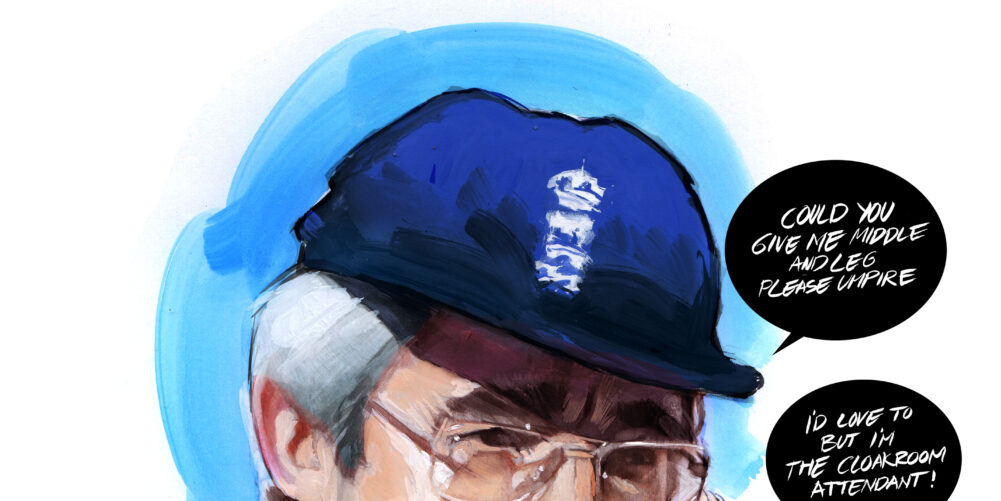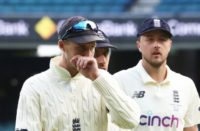IT would have made for an interesting scene. A grey haired, confused looking chap looks up at a man wearing a white jacket and says: “Could you give me middle and leg please, umpire?” And the reply comes back: “I’d love to. But I’m not an umpire, I’m the cloakroom attendant.”
David Steele’s Test match debut against Australia at Lord’s in 1975, when he went down one set of stairs too many and found himself in the members’ toilet, has passed into folklore, with ‘Stan’ as he was known, also joining an exclusive England club of cricketers who were apparently selected whilst participating in a whist drive on a Saga holiday.
Steele looked a lot older than 34 when the phone rang one morning and he heard Tony Greig, the England captain, on the line. “Morning Stan. How do you feel about facing Lillee and Thomson? The money’s okay, and the TCCB picks up the tab for any medical expenses. Hello? Stan? Are you still there?”
But on the back of a phrase coined by Clive Taylor, the cricket correspondent of The Sun, the “bank clerk went to war.” Thommo famously greeted him, once he’d emerged from the Gents, with: “bloody hell it’s Groucho Marx”, but Steele made a dogged half century. Nicknamed “Crime” (doesn’t pay), Steele had been picked because he was almost as hard to prise out as his wallet, and he ended up as the unlikeliest winner ever of the BBC Sports Personality of The Year.
England’s most recent dabble with selecting cricketers apparently long past their sell by date was Gareth Batty, who played against Bangladesh this winter at the age of 39. We all know about England’s well established, if occasionally controversial rotation policy, but to give a chap an 11-year rest between Test matches would seem to be a little extreme.
An even more impressive statistic is Brian Close’s 27 years between Test debut and final appearance, an interval only surpassed by Wilfred Rhodes. At 45, an age when most men’s idea of serious exercise start is taking the dog for a walk, Close was invited to face up to Michael Holding, Andy Roberts, and Wayne Daniel in their pomp. And he got hit so many times that when he took off his shirt his torso resembled a cross between a collection of Victoria plums and a map of the old Empire.
Close played three Tests in that 1976 series, his last coming at Old Trafford when he opened the innings with the 39-year-old John Edrich and scored almost as many runs (20) as he collected bruises in two and a half hours. After which the selectors ditched both of them, and went for a youth policy instead. Chris Balderstone being barely out of nappies at 35.
Baldy was a terrific sportsman, who played football to a high level, and it was his penalty kick past Pat Jennings of Spurs in the 1974-75 season that briefly took his team Carlisle United to the top of the equivalent of the Premier League table. And in the summer of 1975, he pulled off the unique feat of being 80-odd not out at stumps in a county game at Chesterfield, before dashing up the M1 to appear for Doncaster in a Football League match, and then returning to complete his century and take three wickets with left-arm spin to help Leicestershire to their first ever championship title.
However, when the call came through inviting him to take Close’s place in the firing line, Balderstone must have briefly considered saying: “sorry, I think you must have the wrong number” before facing up to Holding and Roberts at Headingley and the Oval. In his first innings he made 35 in three-and-a-half hours, but the abiding memory was of his bat twice coming down about half an hour too late at the Oval. Bowled Holding 0, and bowled Holding 0.
Another celebrated call up for a man well past the first flush of youth had come the previous winter when Colin Cowdrey was invited to join the tour to Australia at the age of 41. The injury list was growing, Tommo was giving interviews about how he enjoyed the sight of Pommy blood, when in flew Cowdrey, a man more used to travelling to Australia from Tilbury to Freemantle, and enjoying a gentle spot of deck quoits en route.
“Good morning. How very nice to meet you” Cowdrey is alleged to have said to Jeff Thomson when walking out to bat in the second Test at Perth. To which Thomson is reported to have replied: “that’s not gonna save you fatso. P**s off.” Which he did eventually, but only after making a plucky 22 before Thommo bowled him.
In the second innings, Cowdrey opened because Brian Luckhurst could hardly grip his bat after being hit on the hand by Thommo, and it was Cowdrey at the non-striker’s end when Thomson very nearly deprived David Lloyd of the ability to father children with a delivery that, even now, I can only watch from behind the sofa.
England’s selectors have a long history of calling up long in the tooth cricketers, and of the eight oldest players ever to appear in a Test match, England have supplied six of them.
Wilfred Rhodes, the oldest at 52, WG Grace (50) George Gunn (50) James Southerton (49) Jack Hobbs (47) and Frank Woolley (47).
Batty’s selection suggests that the policy is still alive and kicking, in which case there is only one possible solution should Alastair Cook, once he’s talked it over with Andrew Strauss, decide that he’s had enough of being in charge. So let’s hear no more about this Joe Root succession – he looks about 12 and is dripping wet behind the ears – and go for someone who fulfils the first criterion of captaincy. Which is to stand at first slip making wise field placings and clever bowling changes.
Okay, now that Mike Brearley is 74, we might not get too many quick singles from him, but he is clearly the man for next winter’s Ashes. And, after all, when Cook has had a decent rest, and taken possession of his concessionary bus pass and winter fuel allowance, we can always call him up again.
This piece originally featured in The Cricket Paper, January 6 2017
Subscribe to the digital edition of The Cricket Paper here












